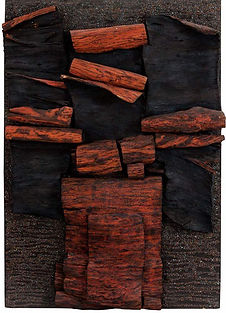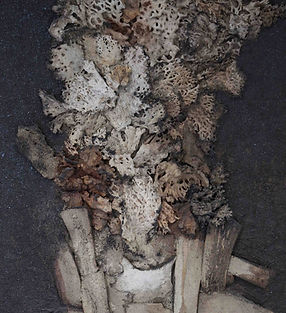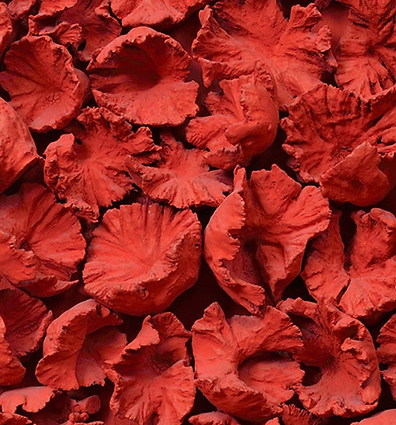%2C%20160%20x%20110%20x%2015%20cm%2C%201991.jpg)

%2C%201990%2C%20Bois%20(Imbauba%20sauvage)%2C%20branches%2C%20colle%20et%20pigments.png)
Tableaux-assemblages
Les tableaux-assemblages de Frans Krajcberg procèdent de la même démarche : faire revivre ce qui est mort. Le moindre détail naturel, que notre œil oublie de regarder, peut nous permettre de nous reconnecter à la nature. Les éléments disparates, ramassés en peine nature - pierres, lianes, coraux, feuilles, bois…- deviennent des univers à part entière auxquels la lumière ou le mouvement imperceptible d’un insecte redonnent vie.
Les fleurs rouges
Dans les années 1960, à Paris, Frans Krajcberg réalise une première série de tableaux /assemblages faits de fleurs sculptées, recouvertes de pigments naturels de couleur rouge, couleur du feu et de la force. Sa démarche est plus proche de la reproduction que de la réappropriation. Ses fleurs peintes dégagent une violence qui associe la force de la vie – le rouge– à un symbole de la mort, car pour lui la fleur porte en elle quelque chose de morbide.
Tableaux-assemblages de fragments naturels
Frans Krajcberg travaille ses tableaux-assemblages faits de fragments naturels en appliquant un alliage de terre et colle, sur du papier séché au soleil, sur lequel ils sont redessinés. Il peut également réaliser de simples collages sur des panneaux de bois. Ses « tableaux-assemblages » « scénographient » les éléments présentés, soulignent leur beauté naturelle pour développer de nouvelles formes, de nouveaux univers, de nouveaux messages.
Ses premiers tableaux de pierres montrent la pierre vivante et vibrante sans artifice. Matière et couleur sont brutes. Aucune œuvre n’est réalisée à partir des mêmes pierres. Il récolte minutieusement quartz, granits, améthystes, cristaux... Transparentes ou opaques, rondes ou pointues, les pierres révèlent un monde de formes, de couleurs inégalables et des vibrations insoupçonnées.


Selon Thérèse Vian, « les tableaux de pierres de Krajcberg sont une silencieuse invitation à une rêverie sans fin, un espace de réflexion qui s'ouvre sur la Nature, sur l'Homme, le visible et l'invisible. Une rêverie de solidité, de dureté et de résistance, qui, rapportée à son œuvre, mettrait en exergue son passé douloureux, toujours sous-jacent. Ce passé qui ne le quitte jamais et qui l'aurait rendu, en apparence, aussi dur et coupant que la pierre. Cette volonté d'évoquer des images coupantes révèle, sans doute, chez l'artiste le besoin d'opérer une véritable opération chirurgicale qui trancherait dans le vif de ce passé douloureux. La pierre aurait donc eu un rôle libératoire pour l'artiste qui n'a plus, à la fin de sa vie, le même besoin de l'utiliser. Elle continuera d'être présente dans ses travaux ultérieurs, mais plus de façon aussi prégnante. Elle ne sera plus qu'un élément de parure esthétique, qui embellira ses arbres calcinés ».
« Ma conclusion est que je suis plus pauvre que la nature, qu'elle crée beaucoup plus que moi. J'y voyais toutes les formes que nous croyons inventer et nous n'inventons rien. Je voulais la dominer. Je faisais des tableaux avec des pierres à Minas Gerais et je voyais que dans la nature même elles étaient beaucoup plus expressives, beaucoup plus vivantes que les tableaux que j'avais fait, alors j'ai abandonné », Frans Krajcberg.
